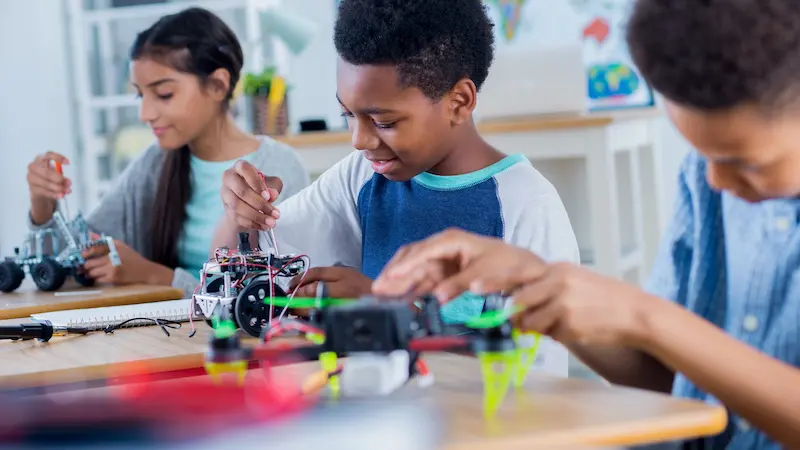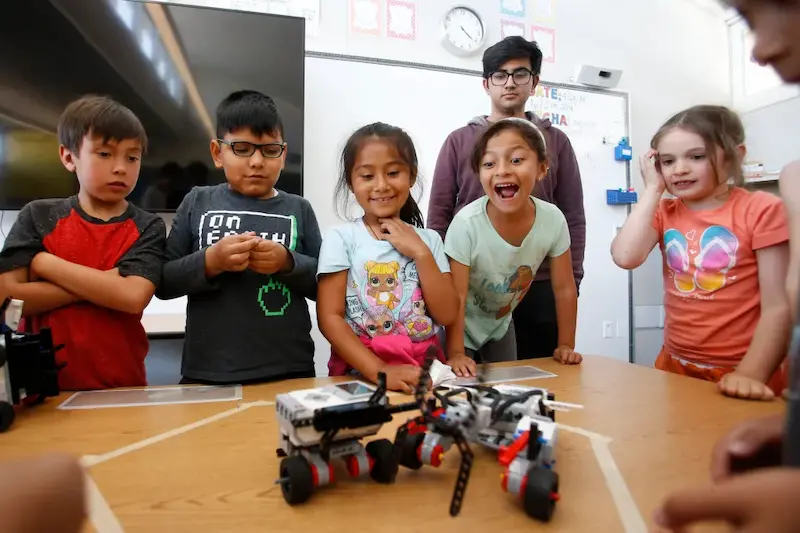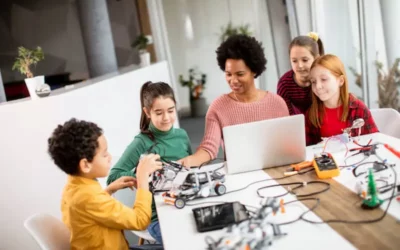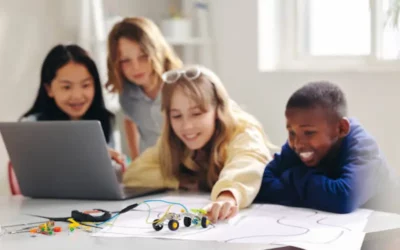As technology grows the whole system is changing rapidly. Technology is involved in almost everything we do in our daily life, and in the future the importance of using technology will only get increased. So, the importance of giving technological skills for kids is a must. Teaching robotics to elementary school kids is a great way to achieve this goal. When we introduce young children to robotics, we pique their curiosity and spark their interest in solving problems and coming up with new ideas.
Through hands-on experiences with robots, kids learn important skills like computer programming, logical thinking, and working together as a team, all of which are really important in the digital age.
In this blog we are going to talk about robotics, its benefits and the overview of the idea. You will get a better understanding of the advantages of getting early childhood education for kids.
Why Robotics in Elementary Education?
Enhancing Critical Thinking Skills
Learning robotics engages students in a journey of critical thinking skills for kids and creative problem-solving. It presents them with challenges that demand logical reasoning, hands-on experimentation, and innovative solutions. By tackling these challenges, children develop sharper analytical minds and the ability to navigate complex problems effectively.
Fostering Creativity and Innovation
Going through the process of designing, building, and programming robots, elementary students are exposed to the world of innovation. They learn to think outside the box, nurture their imagination, and explore unconventional solutions. This creative foundation is a skill that transcends robotics and it is invaluable in any field or endeavor they choose to pursue.
Preparing for Future Careers
As we look toward the future, it’s evident that jobs in science, technology, engineering, and mathematics (STEM) will continue to be in high demand to provide you career growth. Early exposure to robotics not only sparks interest in these subjects not only the part of stem activities for elementary students but also lays the groundwork for future careers in STEM fields. The skills acquired through robotics education give students a competitive edge in a rapidly evolving job market.

Benefits of Robotics for Elementary Students
Improved Problem-Solving Abilities
Robotics classes for kids challenges students to grapple with real-world problems. Whether it’s figuring out how to navigate a maze or designing a robot to perform specific tasks, they gain confidence in their problem-solving abilities. This newfound confidence extends far beyond robotics, enabling them to approach any challenge with resilience and resourcefulness.
Boosting STEM Interest
Robotics serves as a gateway to STEM subjects. It ignites curiosity about science, mathematics, and technology by offering tangible applications. Students see the direct connection between what they learn in the classroom and the exciting possibilities they can create with robotics, fostering a genuine interest in these disciplines.
Building Teamwork and Collaboration
Collaboration is a cornerstone of robotics education. Working on robotics projects encourages students to communicate effectively, share ideas, and cooperate as a team. These essential social skills not only enhance their educational experience but also prepare them for future professions where teamwork is paramount.
At Brightchamps, we’re thrilled to introduce our exciting robotics course for kids – RoboChamps. Our program is designed to spark the curiosity and creativity of young minds while equipping them with essential STEM (Science, Technology, Engineering, and Mathematics) skills.
RoboChamps is a hands-on, interactive learning experience where kids explore the fascinating world of robotics. Through fun and engaging activities, they learn to design, build, and program their own robots, fostering problem-solving abilities and nurturing their passion for technology.
Our experienced instructors are dedicated to providing a supportive and inclusive environment, ensuring that every child can thrive and reach their full potential. RoboChamps is not just a course; it’s a journey that empowers children to become the innovators and creators of tomorrow.
Join us at RoboChamps and let your child embark on a robotic adventure that will shape their future!
Types of Educational Robotics
Educational robotics takes on various forms to cater to diverse learning preferences and needs:
Physical robots: Provide a hands-on experience, allowing students to construct and program real machines. This tangible interaction sparks enthusiasm as children witness the physical manifestation of their ideas.
Programmable robots: Offer versatility, enabling students to code them to perform a wide array of tasks. This adaptability encourages creativity and problem-solving as students explore the limitless possibilities of coding.
Pre-built robots: These are an excellent starting point for beginners, removing the complexity of assembly. This allows students to focus on programming and problem-solving without the added challenge of construction.
Virtual robotics: The virtual robotics simulations create a risk-free learning environment where students can experiment with coding and robot behavior. It’s an ideal option for classrooms with limited resources or those transitioning to digital learning.

Curriculum Integration
Robotics in education seamlessly integrates into various subjects, enriching the educational experience:
Robotics in Science: Robotics brings scientific concepts to life. Students can explore physics, biology, and environmental science by conducting experiments with robots, making abstract ideas concrete.
Mathematics and Coding: Robotics provides a practical application for mathematical concepts. It allows students to see how math is used to solve real-world problems, reinforcing their understanding and mathematical skills.
Robotics in Language Arts: Through creative writing and storytelling, students can describe the adventures of their robot creations. This fusion of language arts and robotics fosters literacy skills while nurturing their imagination.
Cross-disciplinary Learning: Robotics transcends individual subjects, encouraging students to draw connections between different areas of knowledge. This interdisciplinary approach enhances their ability to solve complex, multifaceted problems.
Getting Started with Robotics
Necessary Equipment
To embark on a robotics journey, you’ll need essential tools like a computer, robotics software, and, depending on your chosen approach, physical robots or virtual simulations. These tools form the foundation for hands-on learning.
Also, creating a dedicated space for robotics activities is essential. This ensures that students have a safe, organized, and inspiring environment in which to explore robotics concepts and unleash their creativity.
Safety Considerations
Safety should be a paramount concern when working with robotics. Teaching students responsible robot handling and the ethical use of technology ensures a secure and ethical learning experience.
Teaching Methods and Approaches
Project-Based Learning
Embracing project-based learning of robot programming immerses students in real-world challenges that require them to apply their robotics knowledge. These projects encourage critical thinking, creativity, and problem-solving while making learning enjoyable.
Introducing coding challenges at various difficulty levels allows students to progress and build their coding skills incrementally. These challenges motivate them to tackle increasingly complex problems, boosting their coding proficiency.
Competitions and Robotics Clubs
Participation in robotics competitions or robotics camps and clubs goes beyond the classroom, offering students a multifaceted experience that enriches their education and personal development. These extracurricular activities provide a unique sense of purpose that extends beyond the academic realm.
First and foremost, robotics competitions serve as powerful motivators for students. The prospect of competing against peers from other schools or regions ignites a drive to excel. Students become more invested in their robotics projects, dedicating extra time and effort to refine their designs and programming. This dedication not only improves their technical skills but also instills a sense of discipline and work ethic that will serve them well in any endeavor.
Additionally, robotics competitions create a platform for students to connect with like-minded peers who share their passion for technology and innovation. The bonds formed in robotics clubs are often deep and enduring. Students collaborate, brainstorm, and troubleshoot together, building a strong sense of camaraderie and teamwork.
Robotics and Special Education
There are different robotic courses for kids, robotics education holds unique benefits for special needs students. It offers a supportive and inclusive learning environment where students of all abilities can thrive. There are also online robotic classes for kids for who can’t attend offline classes.
By tailoring robotics classes for kids to accommodate diverse needs, educators create an inclusive environment that celebrates the unique strengths and abilities of every student.
Parental Involvement and Support
Parents play a pivotal role in nurturing their child’s interest in STEM. By engaging in STEM activities at home and encouraging exploration, parents can further fuel their child’s passion for robotics and other scientific pursuits.
Understanding the profound impact of robotics education on their child’s development can empower parents to offer unwavering support. They become champions of their child’s education, advocating for more opportunities in robotics and STEM fields.
Conclusion
In conclusion, robotics for elementary students is not merely an educational tool but a transformative experience. It equips young minds with critical skills, ignites a passion for STEM, and lays the foundation for future success. By embracing robotics education, we empower the next generation to innovate, create, and lead in a technology-driven world.
Let’s take this exciting journey together and witness our children thrive, equipped with the knowledge and skills to shape a brighter future for all of us.
To get your hands on more educational and free resources on coding for kids, robotics for kids, financial education for kids, etc., do check out the BrightCHAMPS Page now!
To get your hands on more such educational, parenting and free resources on coding, robotics, game development, etc., do check out the Brightchamps Blog Page now!
Frequently Asked Questions (FAQ’S)
A1. The ideal age to introduce robotics to elementary students is typically around 7 to 9 years old, which corresponds to grades 2 to 4. At this stage, children have developed the basic cognitive and motor skills needed to engage with robotics concepts effectively. However, it’s essential to remember that every child is unique, and readiness may vary. Some students may show interest and aptitude for robotics at a slightly younger age, while others may need a bit more time to grasp the concepts. Schools can consider offering introductory robotics activities for younger students to gauge their interest and readiness.
A2. Securing funding for robotics programs can be achieved through various avenues:
Grants: Many organizations and foundations offer grants specifically for educational robotics initiatives. Schools can research and apply for these grants to secure financial support.
Corporate Sponsorships: Local businesses or tech companies often sponsor schools’ robotics programs as part of their corporate social responsibility efforts. Schools can approach potential sponsors with proposals outlining the benefits of supporting robotics education.
Parent and Community Involvement: Schools can engage parents and the local community in fundraising efforts. Organizing events, such as robotics fairs or crowdfunding campaigns, can generate financial support.
Budget Allocation: Schools can allocate a portion of their existing budgets to invest in robotics education. Highlighting the long-term benefits of robotics programs can help justify this allocation.
Partnerships: Collaborating with local universities or organizations that promote STEM education can provide access to funding and resources for robotics programs.
DonorsChoose.org: This crowdfunding platform allows teachers and schools to create projects and seek funding from individuals and organizations interested in supporting education.
A3. Yes, there is a wealth of online resources available for teaching robotics to students. These resources cater to various age groups and skill levels:
Online Courses: Platforms like Coursera, edX, and Udacity offer online courses in robotics and programming suitable for educators and students alike.
Educational Websites: Websites like Khan Academy, Code.org, and Tinkercad provide free tutorials, lessons, and coding challenges related to robotics and programming.
YouTube Channels: Many educational YouTube channels, such as RobotLAB and Learn Robotics, offer video tutorials and demonstrations on robotics concepts and projects.
Robotics Software: Open-source robotics software like ROS (Robot Operating System) and Scratch for Robots provide tools for teaching and experimenting with robotics concepts.
Online Communities: Joining online forums and communities like the VEX Forum or the FIRST Robotics Community can help educators and students connect with others, share resources, and seek guidance.
STEM Organizations: Organizations like NASA, IEEE, and STEM.org offer educational resources and activities related to robotics and STEM education.
A4. Robotics education can be particularly beneficial for students with disabilities, offering several advantages:
Accessible Learning: Robotics programs can be adapted to cater to various disabilities, ensuring that all students have equal access to learning opportunities.
Improved Motor Skills: Engaging with robots can help students with physical disabilities improve their fine motor skills through activities like building and programming.
Enhanced Cognitive Skills: Robotics challenges students to think critically and solve problems, promoting cognitive development in students with cognitive disabilities.
Inclusive Environment: Inclusive robotics programs create a supportive and accepting atmosphere where students of all abilities can work together, fostering a sense of belonging.
Boosted Confidence: Successfully completing robotics projects can boost the confidence and self-esteem of students with disabilities, demonstrating their capabilities and potential.
Preparation for Future Careers: Robotics education can open doors to future STEM-related careers, providing students with disabilities with skills that can lead to fulfilling professions in technology and engineering.


 We are an army of educators and passionate learners from BrightChamps family, committed to providing free learning resources to kids, parents & students.
We are an army of educators and passionate learners from BrightChamps family, committed to providing free learning resources to kids, parents & students.














